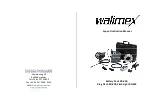
7.1. Electrical abuse
7.1.1. Ripple effects
The nickel-cadmium battery is
tolerant to high ripple and the
only effect is that of increased
water usage. In general, any
commercially available charger
or generator can be used for
commissioning or maintenance
charging of Sunica.plus.
7.1.2. Over-discharge
If more than the designed
capacity is taken out of a battery
then it becomes over-discharged.
This is considered to be an
abuse situation for a battery and
should be avoided.
In the case of lead acid batteries
this will lead to failure of the
battery and is unacceptable.
The Sunica.plus battery is
designed to make recovery from
this situation possible.
7.1.3. Overcharge
Overcharge is the effect of
forcing current through a battery
when it is fully charged. This can
be damaging for a lead acid
battery and, due to its starved
electrolyte technology, seriously
reduce the life of a VRLA battery.
In the case of Sunica.plus, with
its generous electrolyte reserve,
a small degree of overcharge will
not significantly alter the
maintenance period. In the case
of excessive overcharge, water
replenishment is required but
there will be no significant effect
on the life of the battery.
7.2. Mechanical abuse
7.2.1. Shock loads
The Sunica.plus block battery
concept has been tested to both
IEC 68-2-29 (bump tests at 5 g,
10 g and 25 g) and IEC 77
(shock test 3 g).
7.2.2. Vibration resistance
The Sunica.plus block battery
concept has been tested to
IEC 77 for 2 hours at 1 g.
7.2.3. External corrosion
Sunica.plus nickel-cadmium cells
are manufactured in durable
polypropylene, all external metal
components are nickel plated
and these components are
protected by a rigid plastic cover.
7. Special operating factors
20







































